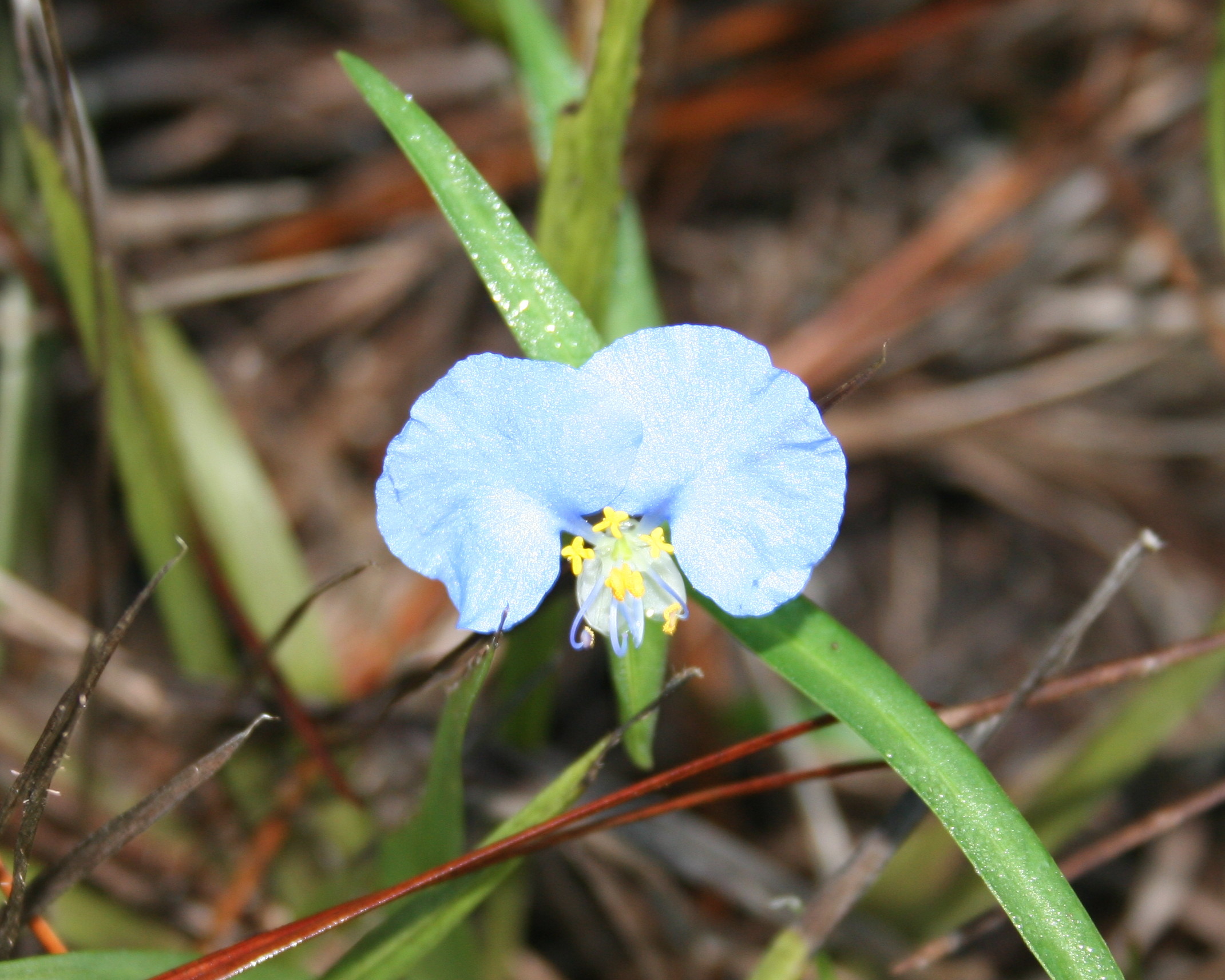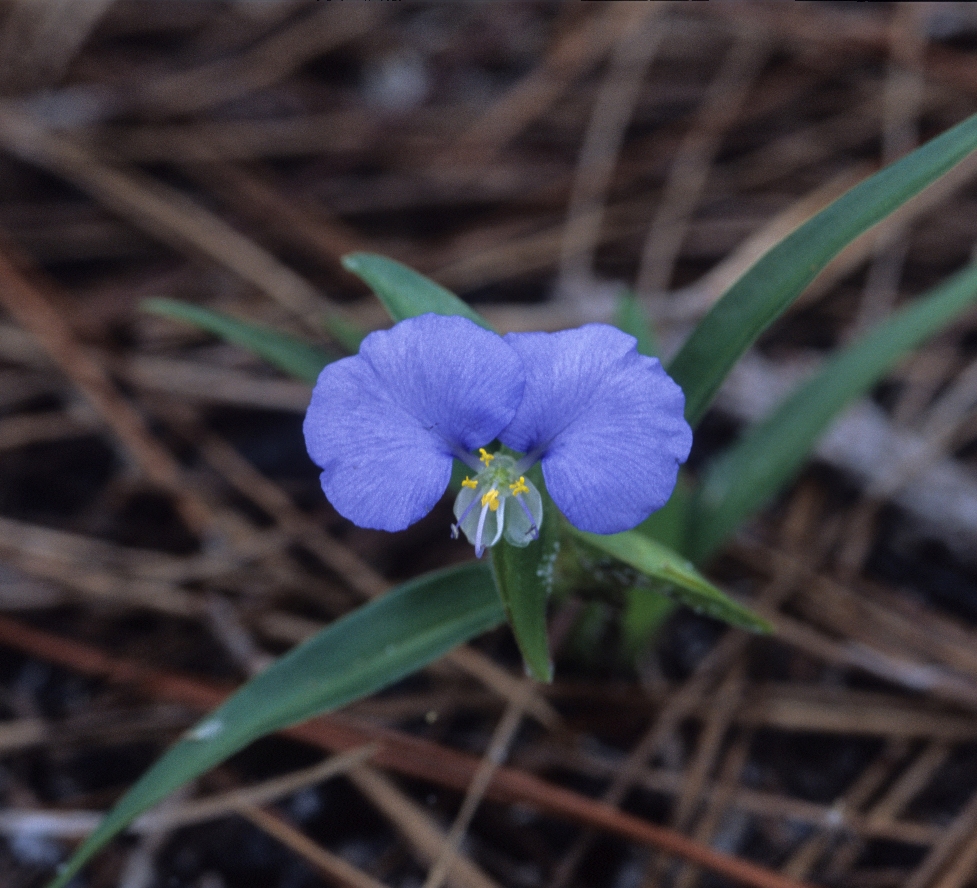Difference between revisions of "Commelina erecta"
| Line 25: | Line 25: | ||
==Description== <!-- Basic life history facts such as annual/perrenial, monoecious/dioecious, root morphology, seed type, etc. --> | ==Description== <!-- Basic life history facts such as annual/perrenial, monoecious/dioecious, root morphology, seed type, etc. --> | ||
| − | A description of ''Commelina erecta'' is provided in [http://efloras.org/florataxon.aspx?flora_id=1&taxon_id=222000043 The Flora of North America]. In Collier County, FL, an albino form was observed.<ref name="Hammer 2017">Observation by Roger Hammer in CREW Marsh, Collier County, FL, May 23, 2017, posted to Florida Flora and Ecosystematics Facebook Group May 23, 2017.</ref> | + | A description of ''Commelina erecta'' is provided in [http://efloras.org/florataxon.aspx?flora_id=1&taxon_id=222000043 The Flora of North America]. In Collier County, FL, an albino form was observed.<ref name="Hammer 2017">Observation by Roger Hammer in CREW Marsh, Collier County, FL, May 23, 2017, posted to Florida Flora and Ecosystematics Facebook Group May 23, 2017.</ref> ''C. erecta'' var. ''angustifolia'' is a trailing plant that can have stems reach as long as 1.3 meters.<ref name= "Weakley"/> |
==Distribution== | ==Distribution== | ||
Revision as of 13:59, 15 April 2019
| Commelina erecta | |
|---|---|

| |
| Photo by Tom Miller, Apalachicola National Forest, FL | |
| Scientific classification | |
| Kingdom: | Plantae |
| Division: | Magnoliophyta - Flowering plants |
| Class: | Liliopsida – Monocotyledons |
| Order: | Commelinales |
| Family: | Commelinaceae |
| Genus: | Commelina |
| Species: | C. erecta |
| Binomial name | |
| Commelina erecta L. | |

| |
| Natural range of Commelina erecta from USDA NRCS Plants Database. | |
Common name: Whitemouth Dayflower; Erect Dayflower; Sand Dayflower
Contents
Taxonomic notes
Synonyms: Commelina angustifolia Michaux; C. crispa Wooton; C. elegans Kunth The Flora of North America.
Varieties: C. erecta Linnaeus var. angustifolia (Michaux) Fernald; C. erecta Linnaeus var. erecta
Description
A description of Commelina erecta is provided in The Flora of North America. In Collier County, FL, an albino form was observed.[1] C. erecta var. angustifolia is a trailing plant that can have stems reach as long as 1.3 meters.[2]
Distribution
C. erecta var. angustifolia is distributed from east North Carolina to south Florida, as well as Texas, Iowa, northwest Nebraska, New Mexico, and Colorado. However, C. erecta var. erecta is distributed from Pennsylvania to Missouri and east Kansas to Florida and Texas.[2]
Ecology
Habitat
C. erecta var. angustifolia can be found in sandhills and other sandy dry sites, dunes and sand flats on barrier islands, and shale barrens and other rocky areas. C. erecta var. erecta can be found in streambanks, woodlands and dry openings, riverbanks, and mesic forests.[2]
Phenology
C. erecta has been observed flowering from May to November with peak inflorescence in June and July.[3][2] In repeated annual censuses conducted in October in permanently marked plots in native longleaf pine-wiregrass communities in southern Georgia, C. erecta appeared only in certain years, seemingly in particularly wet years, and was fairly common in the years that it appeared.[4]
Seed dispersal
This species is thought to be dispersed by gravity. [5]
Pollination
In Daytona Beach, FL, the pollen-feeding bee fly (Poecilognathus punctipennis) was observed visiting C. erecta[6] and performing their unique foraging behavior.[7] The following Hymenoptera families and species were observed visiting flowers of Commelina erecta at Archbold Biological Station:[8]
Halictidae: Augochlorella aurata, Augochloropsis metallica, A. sumptuosa, Lasioglossum nymphalis, L. placidensis
Megachilidae: Megachile brevis pseudobrevis
Conservation and management
Cultivation and restoration
Photo Gallery
References and notes
- ↑ Observation by Roger Hammer in CREW Marsh, Collier County, FL, May 23, 2017, posted to Florida Flora and Ecosystematics Facebook Group May 23, 2017.
- ↑ 2.0 2.1 2.2 2.3 Weakley, A. S. (2015). Flora of the Southern and Mid-Atlantic States. Chapel Hill, NC, University of North Carolina Herbarium.
- ↑ Nelson, G. PanFlora: Plant data for the eastern United States with emphasis on the Southeastern Coastal Plains, Florida, and the Florida Panhandle. www.gilnelson.com/PanFlora/ Accessed: 7 DEC 2016
- ↑ Robertson, K.M. 2017 Pebble Hill Fire Plots database. Tall Timbers Research, Inc., Tallahassee, Florida.
- ↑ Kirkman, L. Katherine. Unpublished database of seed dispersal mode of plants found in Coastal Plain longleaf pine-grasslands of the Jones Ecological Research Center, Georgia.
- ↑ Observation by Peter May in Tiger Bay State Forest, Daytona Beach, FL, May 23, 2017, posted to Florida Flora and Ecosystematics Facebook Group May 23, 2017.
- ↑ Deyrup MA (1988) Pollen-feeding in Poecilognathus punctipennis (Diptera: Bombyliidae). The Florida Entomologist 71(4):597-605.
- ↑ Deyrup, M.A. and N.D. 2015. Database of observations of Hymenoptera visitations to flowers of plants on Archbold Biological Station, Florida, USA.
